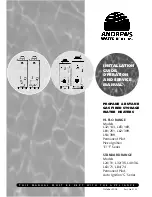
GENERAL AND SAFETY INFORMATION
SECTION 1
It is the duty of manufacturers and suppliers of products for use at work to ensure, so far
as is practicable, that such products are safe and without risk to health when properly
used and to make available to users, adequate information about their safe and proper
operation.
Andrews Water Heaters should only be used in the manner and purpose for which they
were intended and in accordance with the instructions in this manual. Although the
heaters have been manufactured with paramount consideration to safety, certain basic
precautions specified in this manual must be taken by the user.
It is imperative that all users of the heater must be provided with all the information and
instruction necessary to ensure correct and safe operation.
Water systems in buildings have been associated with outbreaks of Legionnaires' Disease,
particularly in health care facilities where occupants are significantly more susceptible to
infection.
In recognition of the risks in hospitals, a Code of Practice for the Control of Legionellae
in Health Care premises has been issued by the Department of Health (1991). Codes of
Practice applicable to other premises have been published by other organisations,
principally the Health and Safety Executive (HS)(G70) and the Chartered Institute of
Building Services Engineers (CIBSE, TM13).
All Codes of Practice draw attention to the design and operation of water systems with
reference to avoidance of factors that favour colonisation by Legionellae bacteria. These
factors include stagnation, lukewarm conditions (20ºC to 45ºC) and the accumulation of
debris, scale and corrosion in the base of tanks and calorifiers.
Andrews Water Heaters has commissioned an independent evaluation of their products
to investigate their resistance to build-up of legionellae bacteria.
Experiments were conducted to determine whether, following a substantial challenge by
legionellae pneumophilia, after overnight and stagnation conditions, the system was
rendered free from viable recoverable legionellae. It was found that at 61ºC, following a
challenge of approximately 107 organisms per litre, within one hour, more than 99.999%
of organisms had been killed. After a subsequent stagnation period, sampling did not
reveal any residual contamination. The design of the base of the water heater precludes
legionellae colonisation, even after build-up of debris. The burner positioning ensures
that the water at the bottom of the heater reaches the same, or higher temperature as in
the rest of the heater.
Based on data obtained through experiment, the Andrews Water Heater can be described
as legionellae resistant as it is considered unlikely that, at the temperature tested, the
organism would colonise the water heater and present a possible health risk.
HEALTH AND
SAFETY
REGULATIONS
1993
EFFECTIVENESS
IN COMBATING
LEGIONELLAE
3
Summary of Contents for L24/31
Page 3: ......
Page 5: ......
Page 14: ...INSTALLATION SECTION 3 9 Bulk Storage Vessel Installation Cylinder Installation Fig 3 ...
Page 22: ...INSTALLATION SECTION 3 17 Fig 8 Fig 8a ...
Page 24: ...INSTALLATION SECTION 3 WATER CONNECTIONS 19 Fig 10 Fig 11 ...
Page 27: ...INSTALLATION SECTION 3 WATER CONNECTIONS 22 Fig 14 Fig 15 ...
Page 30: ...INSTALLATION SECTION 3 WATER CONNECTIONS 25 Fig 18 Fig 19 ...
Page 51: ...PARTS LIST AND ILLUSTRATIONS SECTION 9 46 Hi Flo Model L32 143 Hi Flo Models L65 169 L81 251 ...
Page 53: ...PARTS LIST AND ILLUSTRATIONS SECTION 9 48 Hi Flo Models L62 309 L54 399 ...
Page 58: ...NOTES 53 ...
Page 59: ...NOTES 54 ...
Page 60: ......









































